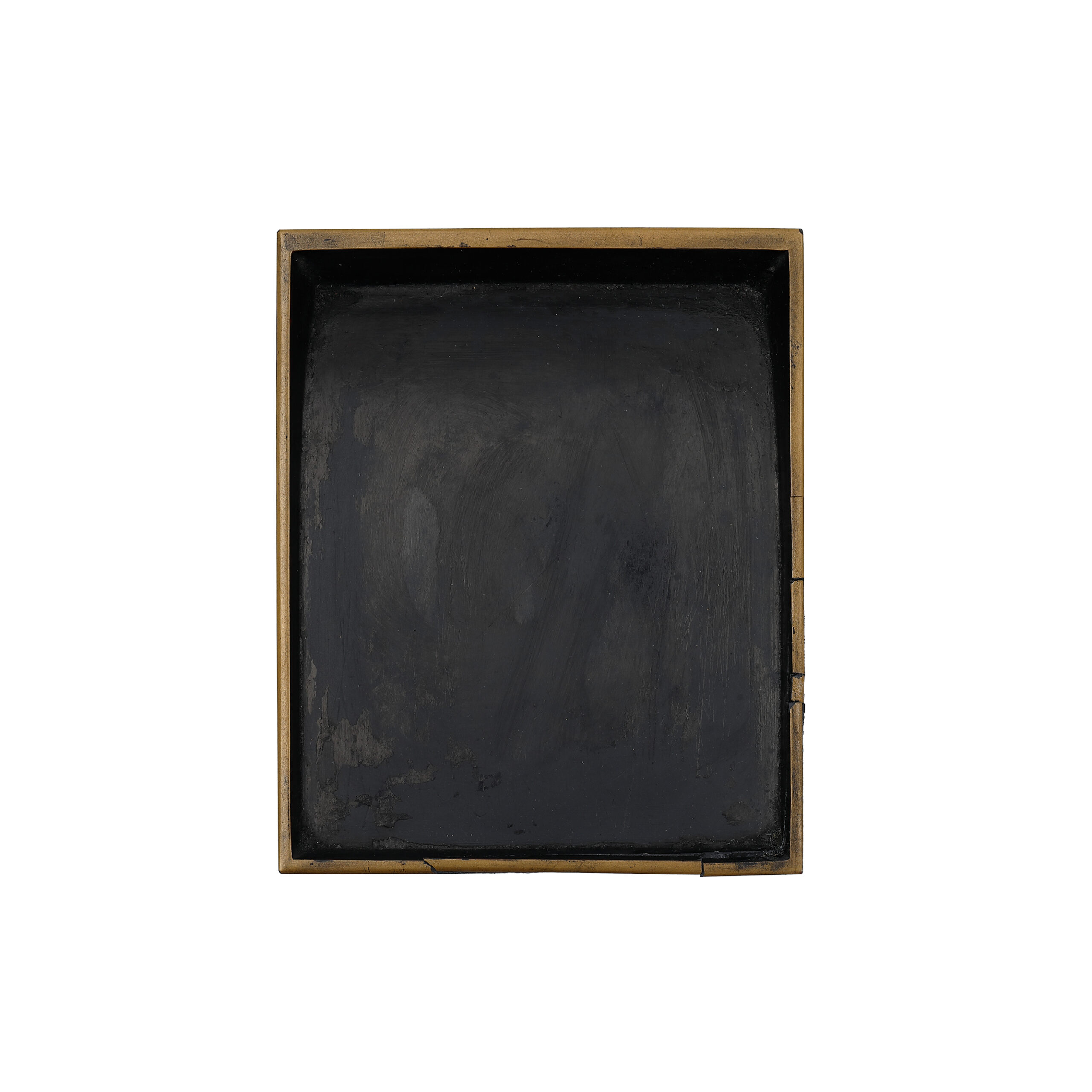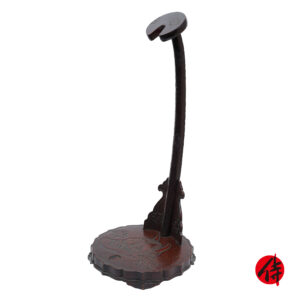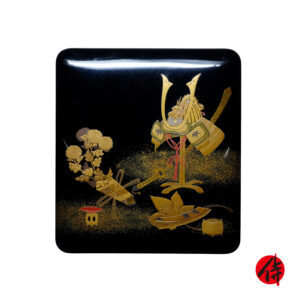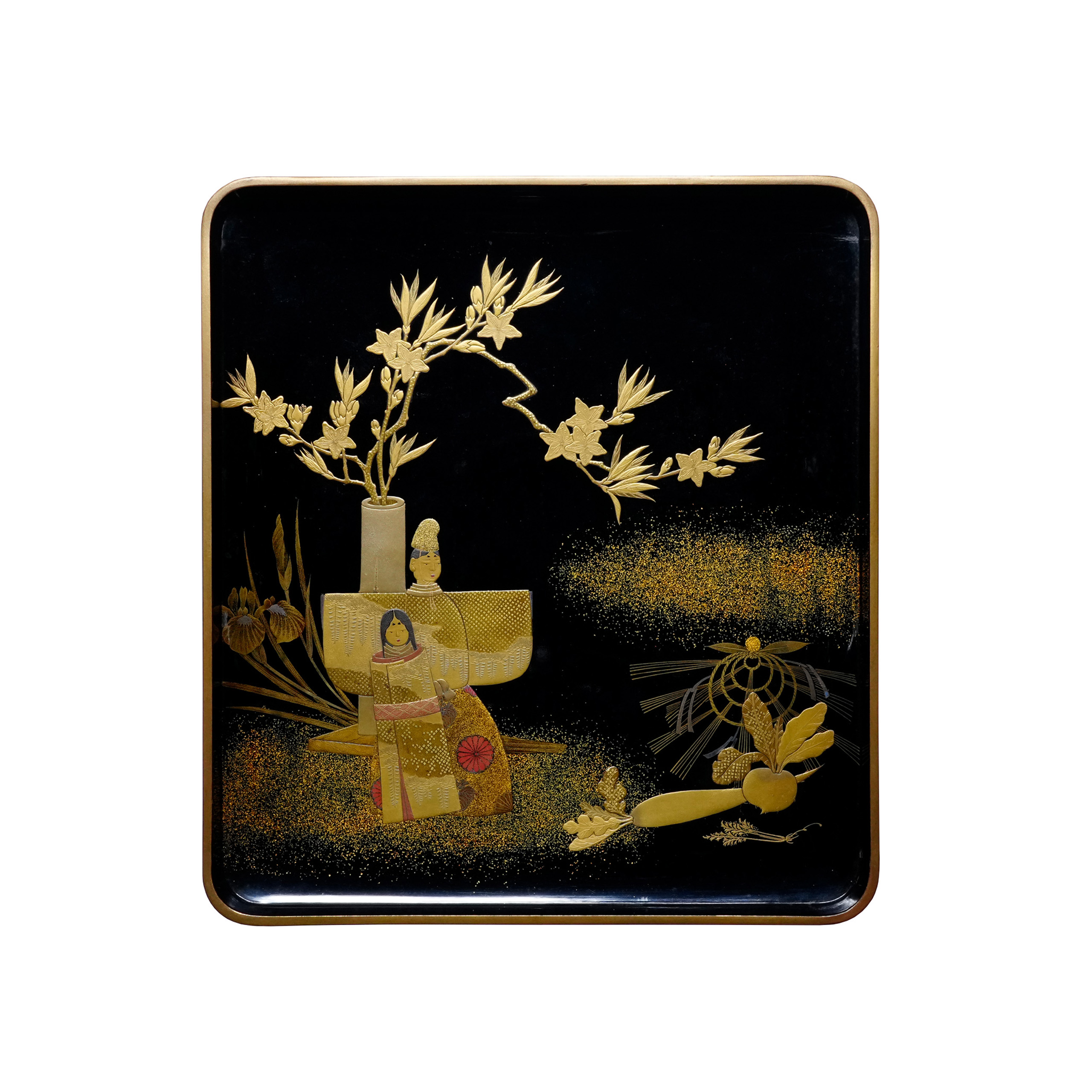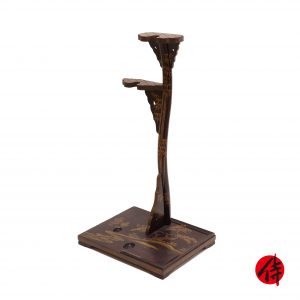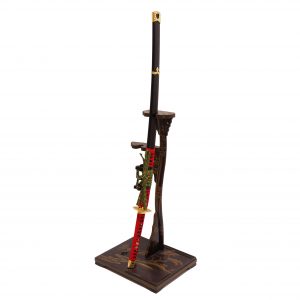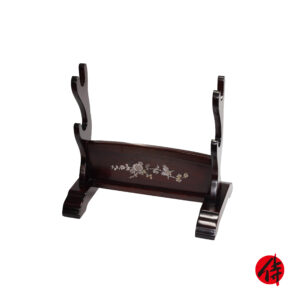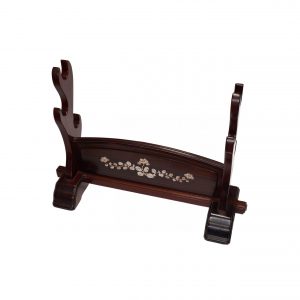Title: Japanese lacquer box-Jakago Chidori Zu
Description
The Suzuri Bako (硯箱) is a type of box in which writing instruments such as writing brushes, ink sticks, or inkstone are stored. Also, some people use it to put a small knife or calendar. The Suzuri Bako is often made from lacquered wood. The *Makie (蒔絵) and the *Raden (螺鈿) are popular ornamental techniques for this kind of item. Artisans developed various skills to decorate boxes.
The Suzuri (硯, inkstone) and Mizusashi (水差し, jug) are stored in this Suzuri Bako. If you have a Sumi (墨, inkstick), you could use these tools for Japanese calligraphy. You could also display this Suzuri Bako to enjoy as a part of the interior decoration in your room. This box is decorated with the traditional Japanese technique; it would make an elegant and luxurious atmosphere. Or, it would be a special gift for someone who enjoys calligraphy.
The theme of this Suzuribako’s design is the Jakago Chidori (蛇篭千鳥), which is the combination pattern of Jakago (蛇篭, gabion) and Chidori (千鳥, plover). Jagago is a basket made of woven bamboo strips and filled with stones. Gabions were used to control the flow of large rivers that needed to regulate the momentum of the water flow, or to reinforce levees.
Plovers are found on riverbanks and seashores, and their playfulness and flight in flocks have become a motif in many patterns. Also, the plover pattern is used as a prayer. The Japanese name of the plover, Chidori, was associated with the word Chidori (千取り, which literally means get a thousand). Therefore, its design contains prayers for victory and wishes for goal achievement.
If you look at the inside of this lid, you will find a beautiful night ocean view with a pine tree (松, Matsu) and the beach on which some seashells and seaweed are washed up on the lower side and the waning crescent moon shown on the right upper side.
As pine trees keep their green color throughout the years by withstanding severe heat and cold, people thought this plant pattern represents eternal youth. Furthermore, its color is called Tokiwa-Iro (常盤色, evergreen trees’ dark green color with brown), and pine trees have another name “Tokiwa-Gi (常盤木).” Tokiwa means immutability, so Tokiwa-Iro is a color that praises green with a wish for longevity and prosperity. It is said this color was appreciated, especially in the Edo period, as a good-luck color. The pine tree design gives us an elegant and noble impression; it might be another reason that people love this motif.
Now, we would like to focus on other calligraphy tools attached to this Suzuri Bako. Next to the inkstone, you can find tools with turtle and lion motifs.
The turtle motif tool might be Bunchin (文鎮, paperweight). There is a proverb saying that turtles, same as cranes, live a long life; therefore, turtle and turtle’s shell pattern called the Kikkou pattern, which is a continuous geometric pattern connecting regular hexagons up and down, represent longevity. In addition, it is said that people wished for eternal prosperity by using the Kikkou design as this continuous hexagonal pattern does not get out of its shape.
Also, a stick-like tool with a lion-face beast is supposed to be Hikka (筆架, brash rack). This beast is called the Karajishi (唐獅子). The Shishi (獅子) means a lion in Japanese, and the Karajishi is a lion brought from the continent to Japan in the Toh period (唐, Tang dynasty, 618-907). The Karajishi typically has curly hair for its head, neck, body, and tail. A simplified pattern of this curly hair is carved as the body hair pattern of the Karajishi on this Inro. In Buddhism, the Karajishi is regarded as a symbol of wisdom, and Monju Bosatu (文殊菩薩, Manjushri Bodhisattva) rides lions. According to a theory, the Karajishi is the origin of Komainu (狛犬, stone guardian dogs that exorcize evil spirits). It shows this beast motif has been familiar to Japanese people since ancient times.
*Makie……A typical Japanese lacquer art technique developed uniquely in Japan for about 1,200 years. Firstly, it needs to draw a picture with lacquer on the surface with a thin brush. Next, sprinkle the gold powder from above to show the pattern before the lacquer hardens. This technique makes a gorgeous and elegant look to works.
*Raden…… It is a kind of decorative technique that is often used for traditional craftworks. It uses the pearl part of seashells and puts it into the engraved surface of lacquer or wood. Thanks to its iridescent luster, it gives a luxurious look to works.
*As this item is an antique, please check each photo and ensure its condition.



【About us】
Samurai Museum is located in Tokyo, Japan, exhibiting antique artifacts related to the Samurai history. Samurai Museum Shop is the place for those who are interested in Japanese culture and craftsmanship. We deal with antique Samurai swords/armor, traditional crafts made in Japan and so on.
【Payment method】
We accept payment through Stripe (Credit card), PayPal, Apple Pay or ChromePay, all of which are secure payment methods. Also, you don’t need to make an account on Stripe for the checkout. If you prefer other payment method, please contact us. You may either pay in JPY, USD, AUD, CAD, EUR, CHF or GBP. The price is set in Japanese Yen. Prices in other currencies are automatically calculated based on the latest exchange rate.

【Shipping duration】
We normally ship via EMS (Express Mail Service) provided by Japan Post. It usually takes at least 5-14 days to deliver the package after you place an order. We offer Free International Shipping as long as we can ship your order by EMS. If you prefer other shipping carriers, please contact us.
We will inform you of the order’s tracking number via email. Please make sure you fill out your valid email address correctly.
*Please keep in mind that due to the spread of COVID-19, there might be possible delays in delivery. If you like to make sure if EMS shipping is available to your country, please contact us.

【How to make sure the condition】
Please keep in mind that what you are going to purchase is an antique item. We uploaded high resolution photos for you to check its condition thoroughly. If you like to see more photos with different angles, please feel free to contact us. We will be happy to send them to you so that you can make informed decision.
It is essential for us to know that you are happy with your choice of Suzuribako and we are prepared to use the best of our ability to serve you.
Would you like see some more Antique items for sale? Please check the link below. We hope you can find your favorite item.
https://www.samuraimuseum.jp/shop/product-category/antique/


